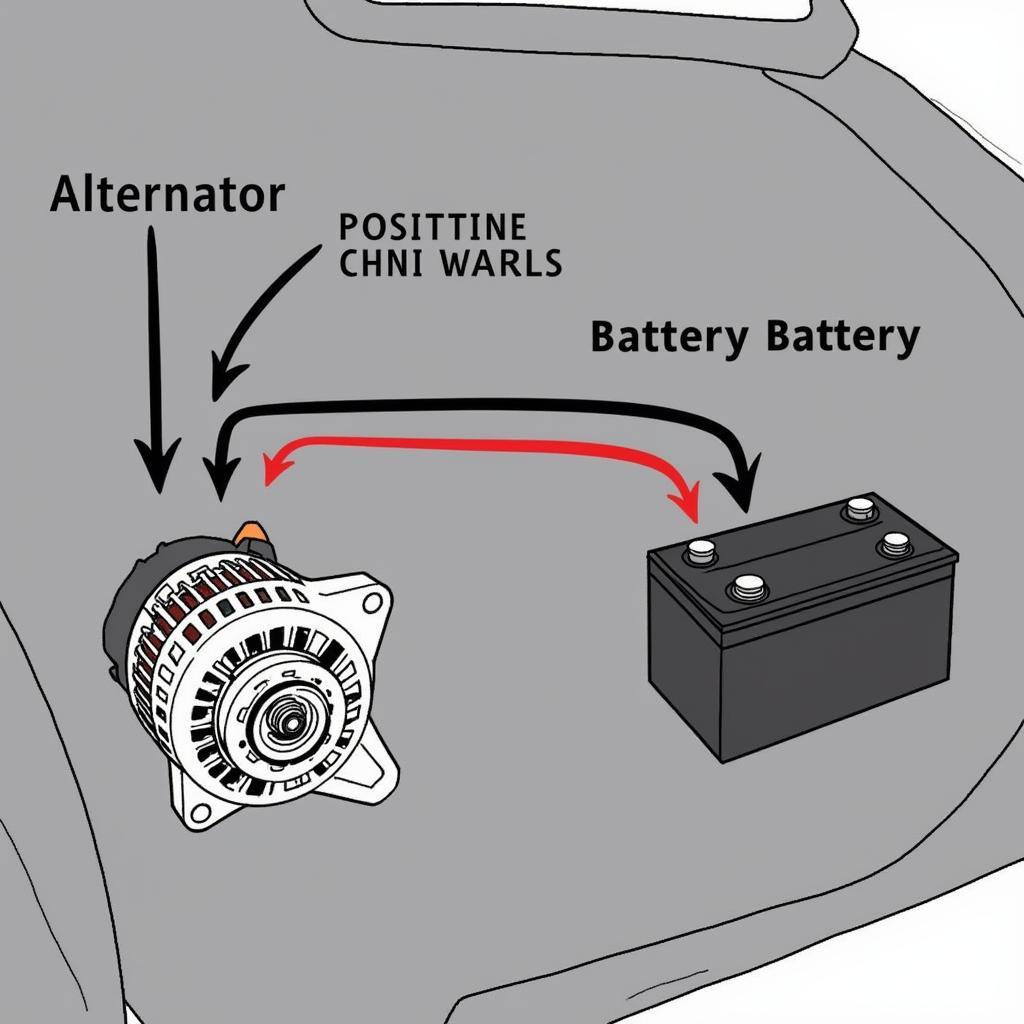Experiencing car trouble? A dead battery or a faulty alternator can be the culprit. This article explores the key differences between a battery problem and an alternator issue, guiding you through diagnosis and providing solutions for a quick fix. alternator vs battery problem
Understanding the Battery’s Role
The battery is your car’s powerhouse, providing the initial jolt of electricity to start the engine. It also powers electrical components when the engine is off, like the lights, radio, and interior electronics. A healthy battery consistently holds a charge and readily delivers power when needed.
Think of the battery as a water reservoir. It stores energy, ready to be released when you turn the key. But just like a reservoir can run dry, a battery can lose its charge, leaving you stranded.
The Alternator: Keeping the Battery Charged
The alternator’s job is to recharge the battery while the engine is running. It works like a generator, converting mechanical energy into electrical energy. This continuous charging cycle ensures your battery stays topped up and ready to power your vehicle.
Imagine the alternator as a pump, constantly replenishing the water reservoir (battery) as it’s being used. If the pump fails, the reservoir eventually empties, even if it was full to begin with.
 Alternator Charging a Car Battery
Alternator Charging a Car Battery
Battery Problem vs Alternator: Spotting the Difference
Knowing how to distinguish between a battery problem and a faulty alternator is crucial. Here’s a breakdown of the common symptoms:
-
Battery Problem: Difficulty starting the car, dim headlights, clicking sound when turning the key, interior lights are weak or non-functional, battery warning light illuminated on the dashboard.
-
Alternator Problem: Dimming headlights while driving, flickering interior lights, unusual whining or growling sounds from the engine compartment, battery warning light illuminated on the dashboard, car stalls while driving.
Testing for a Battery Problem
A simple multimeter test can determine your battery’s health. A reading below 12.6 volts indicates a weak or discharged battery. alternator problems vs battery
Testing for an Alternator Problem
Testing the alternator involves checking the charging voltage while the engine is running. A reading between 13.5 and 14.5 volts suggests a functioning alternator. Anything outside this range could indicate a problem.
Common Causes of Battery and Alternator Failure
-
Battery Failure: Extreme temperatures, old age, excessive parasitic drain, leaving lights on, corrosion on terminals.
-
Alternator Failure: Worn-out brushes, faulty diodes, damaged voltage regulator, broken drive belt.
Solving the Problem: Battery vs Alternator
-
Battery Solution: Jump-start the car, charge the battery, replace the battery. alternator problem vs battery
-
Alternator Solution: Replace the alternator, repair the drive belt, replace the voltage regulator.
Remote Diagnostics and Software Solutions for Modern Vehicles
Modern vehicles rely heavily on software and electronics. As an expert in remote diagnostics, I often utilize software solutions to pinpoint issues with the battery, alternator, and related systems. This involves accessing the vehicle’s onboard computer remotely, retrieving diagnostic trouble codes (DTCs), and performing software updates or reprogramming to address specific issues.
John Smith, a seasoned automotive electrical engineer, states, “Remote diagnostics and software updates have revolutionized the way we troubleshoot and fix car problems. It allows us to quickly and efficiently identify the root cause of issues without even being physically present with the vehicle.”
How to Prevent Future Issues
Regular maintenance, including battery and alternator checks, is key to preventing future breakdowns. Simple steps like cleaning battery terminals and ensuring tight connections can significantly extend the life of your car’s electrical system.
Jane Doe, an automotive diagnostics specialist, advises, “Regular battery and alternator testing, along with addressing any signs of corrosion or wear and tear, can save you from unexpected car troubles down the road.” battery vs alternator failure
Conclusion: Keeping Your Car Running Smoothly
Understanding the difference between a battery problem and an alternator issue is crucial for effective troubleshooting. By applying the diagnostic tips and solutions outlined in this article, you can keep your car running smoothly. Remember, alternator vs battery issue regular maintenance is the best way to avoid being left stranded with a dead battery or a faulty alternator.
FAQs: Battery Problems vs Alternator Issues
- How long does a car battery typically last? Typically 3-5 years.
- Can a bad alternator damage the battery? Yes, a faulty alternator can overcharge or undercharge the battery, leading to premature failure.
- What is a parasitic drain on a car battery? A parasitic drain is a constant draw of electricity from the battery even when the car is off.
- How often should I have my alternator tested? It’s a good idea to have your alternator checked during routine maintenance, especially if you’re experiencing any electrical issues.
- Can I drive my car with a bad alternator? You can drive for a short distance, but the battery will eventually drain, leaving you stranded.
- How much does it cost to replace a car battery? The cost varies depending on the type of battery and your vehicle, but typically ranges from $100 to $300.
- How much does it cost to replace an alternator? Alternator replacement costs vary, generally falling between $300 and $700 depending on the make and model of your vehicle.

